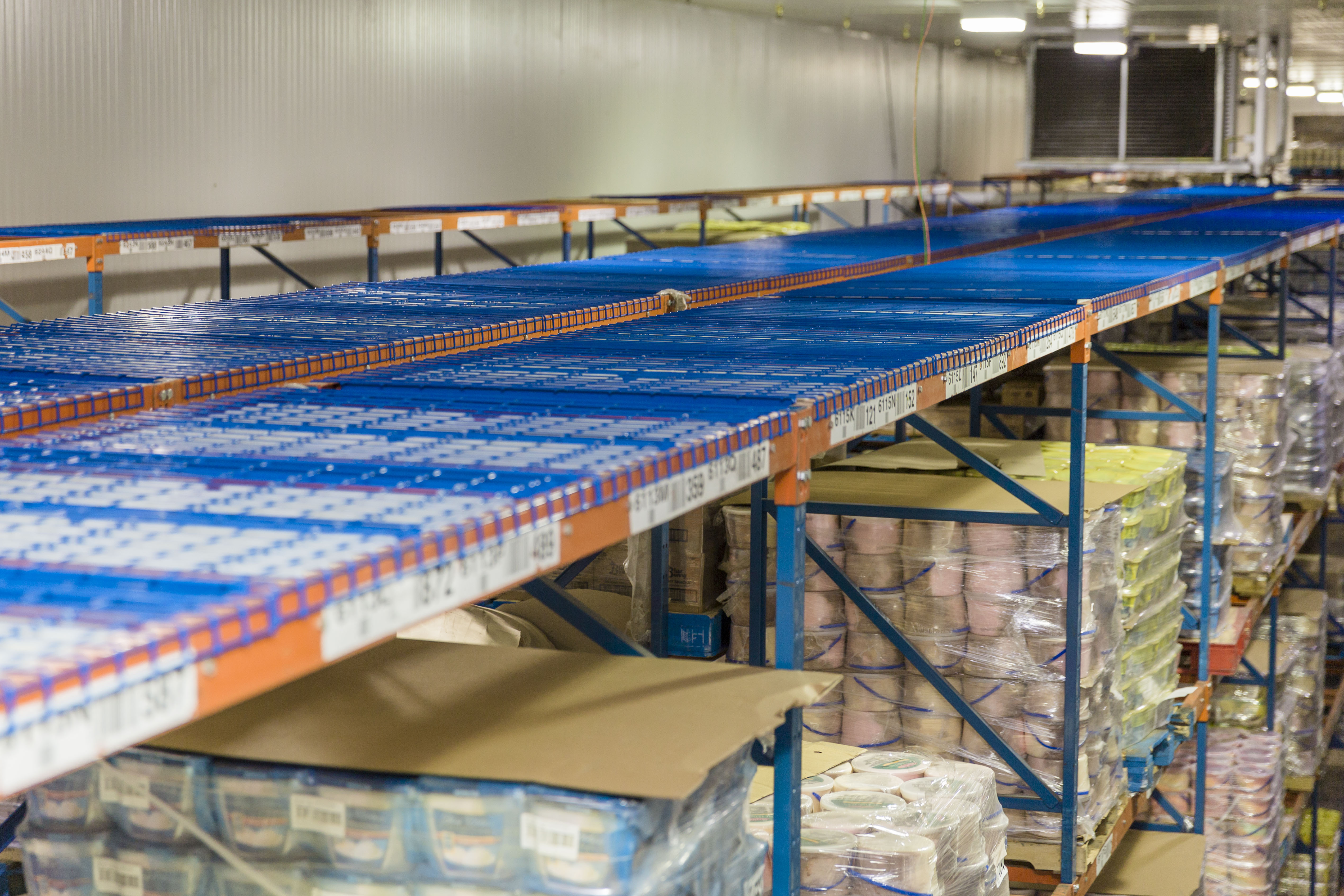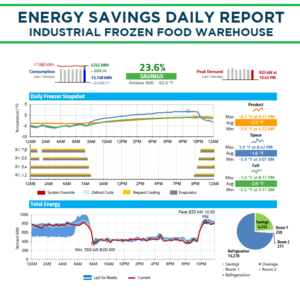
The TES system also reduces energy distribution and delivery challenges for SRP by shifting energy demand to night hours. The passive TES system stores energy at night for subsequent day use, enabling less refrigeration runtime and reduction of load during peak afternoon hours.
“We are very pleased to support this project with Bashas’ and Viking Cold Solutions and to evaluate a technology that shows potential as an energy management tool for us and our customers,” noted Nathan Morey, Manager of SRP Product Development. “SRP is excited to learn more about thermal storage technologies, which can provide energy savings for customers with industrial freezers like Bashas’ and provide long-term benefits to all customers by reducing peak demand during summer months.”
This project includes the installation of the Viking Cold Solutions Thermal Energy Storage (TES) system and 24/7 energy monitoring within the Bashas’ ice-cream freezer at their distribution center. “We continuously evaluate energy efficiency opportunities, as refrigeration is one of our highest operating expenses. We support technologies that provide greater temperature stability, helping us to continually provide low product prices to our customers. SRP is an innovative power utility, and we are excited about this partnership and glad we were able to come together to fund this project,” said Mike Basha, Vice President of Logistics at Bashas’.
SRP will also fund the third-party research analysis for the project, evaluating the TES system’s Phase Change Material (PCM) for its efficiency improvements and effectiveness at shifting energy load from on-peak to off-peak hours. SRP collaborated with Arizona State University’s School of Sustainable Engineering and the Built Environment, along with Nexant’s Utility Services Group, to measure the results of the project and extrapolate the potential impact of this technology on additional low temperature refrigeration loads in the Phoenix area. “Our students are excited to learn more about the potential energy savings and demand reduction impact of this innovative technology, as well as how it can be deployed in more facilities to support reductions in the Phoenix area’s peak load,” commented Kristen Parrish, ASU Assistant Professor.
“Cost effectively managing growing power grid demand and providing reliable and reasonable power prices to customers requires innovative solutions and collaboration from all parties – utilities, academia, industrial customers and technology providers. We anticipate that this project will provide a roadmap for deploying high-impact demand reduction solutions to refrigeration loads that were not previously accessible. As part of our commitment to cold-chain sustainability and reducing environmental impact, we are honored to be the enabling technology,” James Bell, CEO of Viking Cold Solutions stated.
About Viking Cold Solutions:
Viking Cold Solutions™ is a thermal energy management company that makes the world’s cold storage systems more efficient by using proprietary Phase Change Material (PCM) and intelligent controls. The company’s passive Thermal Energy Storage (TES) systems store energy, reduce demand, shift load, monitor customer facilities, and provide thermal back-up protection. The company’s patented TES systems have saved over 8,100 MWh of energy, reduced carbon footprint by over 4,400 metric tons, and prevented more than $13M of product loss. Learn more at vikingcold.com.

 An innovative thermal energy storage system provides significant cost savings, enhanced product monitoring, and protection for low temperature cold storage operators.
An innovative thermal energy storage system provides significant cost savings, enhanced product monitoring, and protection for low temperature cold storage operators. Bills – no one likes getting them, especially when they’re hard to decipher. Energy bills can be particularly challenging to understand, with few people able to wrap their heads around all the technical elements listed on a monthly statement. But for businesses with operations that consume a great deal of energy, being able to make sense of a utility bill is critical to ensuring expenses stay low.
Bills – no one likes getting them, especially when they’re hard to decipher. Energy bills can be particularly challenging to understand, with few people able to wrap their heads around all the technical elements listed on a monthly statement. But for businesses with operations that consume a great deal of energy, being able to make sense of a utility bill is critical to ensuring expenses stay low. Anyone that pays an electric bill knows that cooling measures such as air conditioning and refrigeration require a lot of energy and cost a lot of money. So imagine the energy requirement and expense of running the refrigeration systems found in cold storage warehouses, supermarkets, and food processing facilities where temperature must be maintained at a specific level to avoid product spoilage. It’s a costly operation, but fortunately new technologies are emerging to provide thermal energy management to companies looking to cut refrigeration costs through improved energy efficiency.
Anyone that pays an electric bill knows that cooling measures such as air conditioning and refrigeration require a lot of energy and cost a lot of money. So imagine the energy requirement and expense of running the refrigeration systems found in cold storage warehouses, supermarkets, and food processing facilities where temperature must be maintained at a specific level to avoid product spoilage. It’s a costly operation, but fortunately new technologies are emerging to provide thermal energy management to companies looking to cut refrigeration costs through improved energy efficiency.  Thermal Energy Storage (TES) is an effective energy savings strategy that allows excess thermal energy to be collected and stored for later use—most typically when electrical utility demand charges are at their daily peak. TES systems have been in use for decades, mainly to lower energy costs and ease grid demand for air conditioning applications.
Thermal Energy Storage (TES) is an effective energy savings strategy that allows excess thermal energy to be collected and stored for later use—most typically when electrical utility demand charges are at their daily peak. TES systems have been in use for decades, mainly to lower energy costs and ease grid demand for air conditioning applications. Viking Cold’s Thermal Energy Storage (TES) has many benefits for commercial businesses with high refrigeration based loads. Here are four of the main benefits that TES can provide.
Viking Cold’s Thermal Energy Storage (TES) has many benefits for commercial businesses with high refrigeration based loads. Here are four of the main benefits that TES can provide.
 consumption using Viking Cold’s Thermal Energy Storage Solution. Viking Cold’s patented thermal energy cells were installed in the ceiling of Butterfield and Vallis’ 10,000-square-foot warehouse freezer in 2015. The Thermal Energy Storage System absorbs heat, allowing the chillers to run less frequently and keeping the warehouse within a few degrees of -18º Celsius.
consumption using Viking Cold’s Thermal Energy Storage Solution. Viking Cold’s patented thermal energy cells were installed in the ceiling of Butterfield and Vallis’ 10,000-square-foot warehouse freezer in 2015. The Thermal Energy Storage System absorbs heat, allowing the chillers to run less frequently and keeping the warehouse within a few degrees of -18º Celsius. 